The Application of Two-Dimensional Continuous Wavelet Transform Based on Active Infrared Thermography for Subsurface Defect Detection in Concrete Structures
Abstract
1. Introduction
2. Literature Review
3. Theoretical Background of CWT
4. Experimental Program
4.1. Concrete Specimen
4.2. Active IRT Setup
4.2.1. Temperature and Humidity Sensor
4.2.2. Infrared Camera
4.2.3. Thermal Excitation Source
5. Data Acquisition and Processing
5.1. Thermal Contrast Approach
5.2. Wavelet-Based Approach
6. Results and Discussion
6.1. Surface Temperature Profiles
6.2. Thermal Contrast
6.3. Analysis of 2D-CWT Images
7. Conclusions
Author Contributions
Funding
Institutional Review Board Statement
Informed Consent Statement
Data Availability Statement
Acknowledgments
Conflicts of Interest
Appendix A
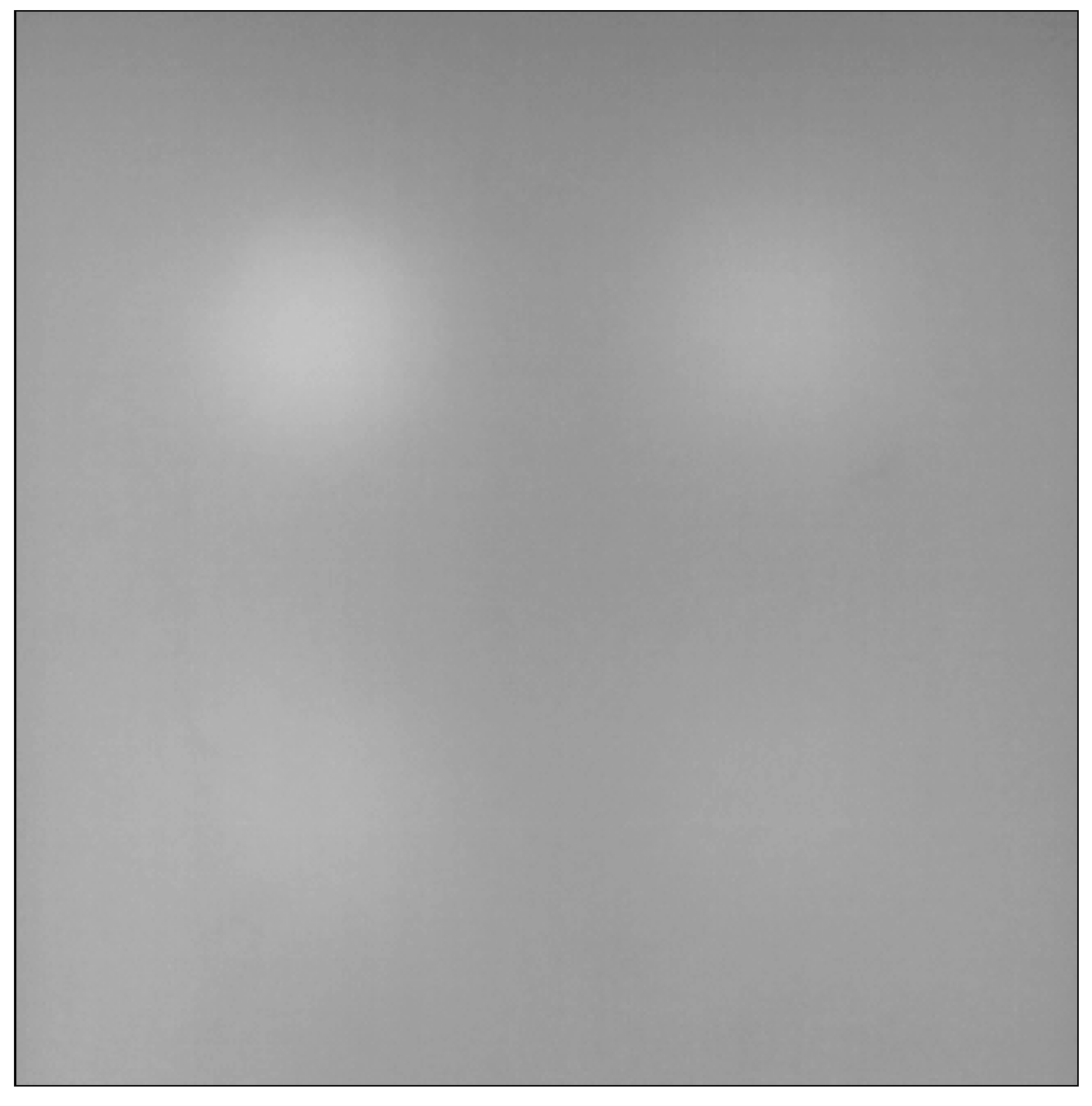

References
- Lerma, C.; Mas, Á.; Gil, E.; Vercher, J.; Peñalver, M.J. Pathology of Building Materials in Historic Buildings. Relationship between Laboratory Testing and Infrared Thermography. Mater. Constr. 2014, 64, e009. [Google Scholar] [CrossRef]
- Garrido, I.; Lagüela, S.; Otero, R.; Arias, P. Thermographic Methodologies Used in Infrastructure Inspection: A Review—Data Acquisition Procedures. Infrared Phys. Technol. 2020, 111, 103481. [Google Scholar] [CrossRef]
- Aggelis, D.G.; Kordatos, E.Z.; Soulioti, D.V.; Matikas, T.E. Combined Use of Thermography and Ultrasound for the Characterization of Subsurface Cracks in Concrete. Constr. Build. Mater. 2010, 24, 1888–1897. [Google Scholar] [CrossRef]
- Tavukçuoğlu, A.; Akevren, S.; Grinzato, E. In Situ Examination of Structural Cracks at Historic Masonry Structures by Quantitative Infrared Thermography and Ultrasonic Testing. J. Mod. Opt. 2010, 57, 1779–1789. [Google Scholar] [CrossRef]
- Yousefi, B.; Sfarra, S.; Sarasini, F.; Castanedo, C.I.; Maldague, X.P.V. Low-Rank Sparse Principal Component Thermography (Sparse-PCT): Comparative Assessment on Detection of Subsurface Defects. Infrared Phys. Technol. 2019, 98, 278–284. [Google Scholar] [CrossRef]
- Janků, M.; Cikrle, P.; Grošek, J.; Anton, O.; Stryk, J. Comparison of Infrared Thermography, Ground-Penetrating Radar and Ultrasonic Pulse Echo for Detecting Delaminations in Concrete Bridges. Constr. Build. Mater. 2019, 225, 1098–1111. [Google Scholar] [CrossRef]
- Barreira, E.; Almeida, R.M.S.F.; Delgado, J.M.P.Q. Infrared Thermography for Assessing Moisture Related Phenomena in Building Components. Constr. Build. Mater. 2016, 110, 251–269. [Google Scholar] [CrossRef]
- Barbosa, M.T.G.; Rosse, V.J.; Laurindo, N.G. Thermography Evaluation Strategy Proposal Due Moisture Damage on Building Facades. J. Build. Eng. 2021, 43, 102555. [Google Scholar] [CrossRef]
- Doshvarpassand, S.; Wu, C.; Wang, X. An Overview of Corrosion Defect Characterization Using Active Infrared Thermography. Infrared Phys. Technol. 2019, 96, 366–389. [Google Scholar] [CrossRef]
- Kobayashi, K.; Banthia, N. Corrosion Detection in Reinforced Concrete Using Induction Heating and Infrared Thermography. J. Civ. Struct. Health Monit. 2011, 1, 25–35. [Google Scholar] [CrossRef]
- Sakka, Z.; Taha, M.; Saleh, A.K.; Karam, H.; Qazweeni, J. Structural assessment of underground water reservoirs. In Structures Congress; Techno-Press: Incheon, Korea, 2018. [Google Scholar]
- Ahmed, H.; La, H.M.; Gucunski, N. Review of Non-Destructive Civil Infrastructure Evaluation for Bridges: State-of-the-Art Robotic Platforms, Sensors and Algorithms. Sensors 2020, 20, 3954. [Google Scholar] [CrossRef] [PubMed]
- Pozzer, S.; Azar, E.R.; Rosa, F.D.; Pravia, Z.M.C. Semantic Segmentation of Defects in Infrared Thermographic Images of Highly Damaged Concrete Structures. J. Perform. Constr. Facil. 2021, 35, 4020131. [Google Scholar] [CrossRef]
- Omar, T.; Nehdi, M.L. Remote Sensing of Concrete Bridge Decks Using Unmanned Aerial Vehicle Infrared Thermography. Autom. Constr. 2017, 83, 360–371. [Google Scholar] [CrossRef]
- Omar, T.; Nehdi, M.L.; Zayed, T. Infrared Thermography Model for Automated Detection of Delamination in RC Bridge Decks. Constr. Build. Mater. 2018, 168, 313–327. [Google Scholar] [CrossRef]
- Abu Dabous, S.; Yaghi, S.; Alkass, S.; Moselhi, O. Concrete Bridge Deck Condition Assessment Using IR Thermography and Ground Penetrating Radar Technologies. Autom. Constr. 2017, 81, 340–354. [Google Scholar] [CrossRef]
- Sham, J.F.C.; Lai, W.W.L.; Chan, W.; Koh, C.L. Imaging and Condition Diagnosis of Underground Sewer Liners via Active and Passive Infrared Thermography: A Case Study in Singapore. Tunn. Undergr. Space Technol. 2019, 84, 440–450. [Google Scholar] [CrossRef]
- Cheng, C.; Shen, Z. Semi Real-Time Detection of Subsurface Consolidation Defects during Concrete Curing Stage. Constr. Build. Mater. 2021, 270, 121489. [Google Scholar] [CrossRef]
- Kulkarni, N.N.; Dabetwar, S.; Benoit, J.; Yu, T.; Sabato, A. Comparative Analysis of Infrared Thermography Processing Techniques for Roadways’ Sub-Pavement Voids Detection. NDT Int. 2022, 129, 102652. [Google Scholar] [CrossRef]
- Janků, M.; Stryk, J. Application of Infrared Camera to Bituminous Concrete Pavements: Measuring Vehicle. IOP Conf. Ser. Mater. Sci. Eng. 2017, 236, 012104. [Google Scholar] [CrossRef]
- Wiecek, B. Review on thermal image processing for passive and active thermography. In Proceedings of the IEEE Engineering in Medicine and Biology 27th Annual Conference, IEEE, Shanghai, China, 17–18 January 2006; pp. 686–689. [Google Scholar]
- Milovanović, B.; Banjad Pečur, I. Review of Active IR Thermography for Detection and Characterization of Defects in Reinforced Concrete. J. Imaging 2016, 2, 11. [Google Scholar] [CrossRef]
- Usamentiaga, R.; Venegas, P.; Guerediaga, J.; Vega, L.; Molleda, J.; Bulnes, F. Infrared Thermography for Temperature Measurement and Non-Destructive Testing. Sensors 2014, 14, 12305–12348. [Google Scholar] [CrossRef] [PubMed]
- Bagavathiappan, S.; Lahiri, B.B.; Saravanan, T.; Philip, J.; Jayakumar, T. Infrared Thermography for Condition Monitoring-A Review. Infrared Phys. Technol. 2013, 60, 35–55. [Google Scholar] [CrossRef]
- Zheng, Y.; Wang, S.; Zhang, P.; Xu, T.; Zhuo, J. Application of Nondestructive Testing Technology in Quality Evaluation of Plain Concrete and RC Structures in Bridge Engineering: A Review. Buildings 2022, 12, 843. [Google Scholar] [CrossRef]
- Raja, B.N.K.; Miramini, S.; Duffield, C.; Sofi, M.; Mendis, P.; Zhang, L. The Influence of Ambient Environmental Conditions in Detecting Bridge Concrete Deck Delamination Using Infrared Thermography (IRT). Struct. Control Health Monit. 2020, 27, e2506. [Google Scholar] [CrossRef]
- Dudzik, S. Analysis of the Accuracy of a Neural Algorithm for Defect Depth Estimation Using PCA Processing from Active Thermography Data. Infrared Phys. Technol. 2013, 56, 1–7. [Google Scholar] [CrossRef]
- Kylili, A.; Fokaides, P.A.; Christou, P.; Kalogirou, S.A. Infrared Thermography (IRT) Applications for Building Diagnostics: A Review. Appl. Energy 2014, 134, 531–549. [Google Scholar] [CrossRef]
- Garrido, I.; Barreira, E.; Almeida, R.M.; Lagüela, S. Introduction of Active Thermography and Automatic Defect Segmentation in the Thermographic Inspection of Specimens of Ceramic Tiling for Building Façades. Infrared Phys. Technol. 2022, 121, 104012. [Google Scholar] [CrossRef]
- Lai, W.L.; Poon, C.S. Applications of Nondestructive Evaluation Techniques in Concrete Inspection. HKIE Trans. 2012, 19, 34–41. [Google Scholar] [CrossRef]
- Mohan, A.; Poobal, S. Crack Detection Using Image Processing: A Critical Review and Analysis. Alex. Eng. J. 2018, 57, 787–798. [Google Scholar] [CrossRef]
- Noszczyk, P.; Nowak, H. Inverse Contrast in Non-Destructive Materials Research by Using Active Thermography. Materials 2019, 12, 835. [Google Scholar] [CrossRef]
- Kurita, K.; Oyado, M.; Tanaka, H.; Tottori, S. Active Infrared Thermographic Inspection Technique for Elevated Concrete Structures Using Remote Heating System. Infrared Phys. Technol. 2009, 52, 208–213. [Google Scholar] [CrossRef]
- Gavrilov, D.; Maev, R. Extraction of Independent Structural Images for Principal Component Thermography. Appl. Sci. 2018, 8, 459. [Google Scholar] [CrossRef]
- Lopez, F.; Ibarra-Castanedo, C.; de Paulo Nicolau, V.; Maldague, X. Optimization of Pulsed Thermography Inspection by Partial Least-Squares Regression. NDT E Int. 2014, 66, 128–138. [Google Scholar] [CrossRef]
- Marchetti, M.; Boucher, V.; Dumoulin, J.; Colomb, M. Retrieving Visibility Distance in Fog Combining Infrared Thermography, Principal Components Analysis and Partial Least-Square Regression. Infrared Phys. Technol. 2015, 71, 289–297. [Google Scholar] [CrossRef]
- Fan, Z.; Bi, D.; Xiong, L.; Ma, S.; He, L.; Ding, W. Dim Infrared Image Enhancement Based on Convolutional Neural Network. Neurocomputing 2018, 272, 396–404. [Google Scholar] [CrossRef]
- Khan, F.; Bolhassani, M.; Kontsos, A.; Hamid, A.; Bartoli, I. Modeling and Experimental Implementation of Infrared Thermography on Concrete Masonry Structures. Infrared Phys. Technol. 2015, 69, 228–237. [Google Scholar] [CrossRef]
- Vega Díaz, J.J.; Vlaminck, M.; Lefkaditis, D.; Orjuela Vargas, S.A.; Luong, H. Solar Panel Detection within Complex Backgrounds Using Thermal Images Acquired by UAVs. Sensors 2020, 20, 6219. [Google Scholar] [CrossRef]
- Selim, H.; Piñal Moctezuma, F.; Delgado Prieto, M.; Francisco Trull, J.; Romeral Martínez, L.; Cojocaru, C. Wavelet transform applied to internal defect detection by means of laser ultrasound. In Wavelet Transform and Complexity; Baleanu, D., Ed.; IntechOpen: London, UK, 2019; pp. 95–109. [Google Scholar]
- Mahdian Parrany, A. Damage Detection in Circular Cylindrical Shells Using Active Thermography and 2-D Discrete Wavelet Analysis. Thin-Walled Struct. 2019, 136, 34–49. [Google Scholar] [CrossRef]
- Ziopaja, K.; Pozorski, Z.; Garstecki, A. Damage Detection Using Thermal Experiments and Wavelet Transformation. Inverse Probl. Sci. Eng. 2011, 19, 127–153. [Google Scholar] [CrossRef]
- Różański, L.; Ziopaja, K. Applicability Analysis of IR Thermography and Discrete Wavelet Transform for Technical Conditions Assessment of Bridge Elements. Quant. InfraRed Thermogr. J. 2019, 16, 87–110. [Google Scholar] [CrossRef]
- Chrysafi, A.P.; Athanasopoulos, N.; Siakavellas, N.J. Damage Detection on Composite Materials with Active Thermography and Digital Image Processing. Int. J. Therm. Sci. 2017, 116, 242–253. [Google Scholar] [CrossRef]
- Shrestha, R.; Chung, Y.; Kim, W. Wavelet Transform Applied to Lock-In Thermographic Data for Detection of Inclusions in Composite Structures: Simulation and Experimental Studies. Infrared Phys. Technol. 2019, 96, 98–112. [Google Scholar] [CrossRef]
- Moradi, M.; Safizadeh, M.S. Edge Disbond Detection of Carbon/Epoxy Repair Patch on Aluminum Using Thermography. Compos. Sci. Technol. 2019, 179, 41–53. [Google Scholar] [CrossRef]
- Mehta, A.; Goyal, D.; Choudhary, A.; Pabla, B.S.; Belghith, S. Machine Learning-Based Fault Diagnosis of Self-Aligning Bearings for Rotating Machinery Using Infrared Thermography. Math. Probl. Eng. 2021, 2021, 9947300. [Google Scholar] [CrossRef]
- Choudhary, A.; Goyal, D.; Letha, S.S. Infrared Thermography-Based Fault Diagnosis of Induction Motor Bearings Using Machine Learning. IEEE Sens. J. 2021, 21, 1727–1734. [Google Scholar] [CrossRef]
- Tong, Z.; Xie, S.; Chen, H.; Qiu, J.; Cai, W.; Pei, C.; Chen, Z.; Uchimoto, T.; Takagi, T. Quantitative Mapping of Depth Profile of Fatigue Cracks Using Eddy Current Pulsed Thermography Assisted by PCA and 2D Wavelet Transformation. Mech. Syst. Signal Process. 2022, 175, 109139. [Google Scholar] [CrossRef]
- Yadav, A.; Sengar, N.; Issac, A.; Dutta, M.K. Image Processing Based Acrylamide Detection from Fried Potato Chip Images Using Continuous Wavelet Transform. Comput. Electron. Agric. 2018, 145, 349–362. [Google Scholar] [CrossRef]
- Shiji, T.P.; Remya, S.; Lakshmanan, R.; Pratab, T.; Thomas, V. Evolutionary Intelligence for Breast Lesion Detection in Ultrasound Images: A Wavelet Modulus Maxima and SVM Based Approach. J. Intell. Fuzzy Syst. 2020, 38, 6279–6290. [Google Scholar] [CrossRef]
- Reddy, V.K.; Siramoju, K.K.; Sircar, P. Object detection by 2-D continuous wavelet transform. In Proceedings of the International Conference on Computational Science and Computational Intelligence, IEEE, Las Vegas, NV, USA, 10–13 March 2014; pp. 162–167. [Google Scholar]
- Cotič, P.; Kolarič, D.; Bosiljkov, V.B.; Bosiljkov, V.; Jagličić, Z. Determination of the Applicability and Limits of Void and Delamination Detection in Concrete Structures Using Infrared Thermography. NDT Int. 2015, 74, 87–93. [Google Scholar] [CrossRef]
- Pedram, M.; Taylor, S.; Robinson, D.; Hamill, G.; O’Brien, E.; Uddin, N. Experimental Investigation of Subsurface Defect Detection in Concretes by Infrared Thermography and Convection Heat Exchange. J. Civ. Struct. Health Monit. 2022. [Google Scholar] [CrossRef]
- Huh, J.; Mac, V.; Tran, Q.; Lee, K.-Y.; Lee, J.-I.; Kang, C. Detectability of Delamination in Concrete Structure Using Active Infrared Thermography in Terms of Signal-to-Noise Ratio. Appl. Sci. 2018, 8, 1986. [Google Scholar] [CrossRef]
- Tran, Q.H.; Huh, J.; Mac, V.H.; Kang, C.; Han, D. Effects of Rebars on the Detectability of Subsurface Defects in Concrete Bridges Using Square Pulse Thermography. NDT Int. 2018, 100, 92–100. [Google Scholar] [CrossRef]
- Mac, V.H.; Huh, J.; Doan, N.S.; Shin, G.; Lee, B.Y. Thermography-Based Deterioration Detection in Concrete Bridge Girders Strengthened with Carbon Fiber-Reinforced Polymer. Sensors 2020, 20, 3263. [Google Scholar] [CrossRef]
- Milovanović, B.; Banjad Pečur, I.; Štirmer, N. The Methodology for Defect Quantification in Concrete Using IR Thermography. J. Civ. Eng. Manag. 2017, 23, 573–582. [Google Scholar] [CrossRef][Green Version]
- Cheng, C.; Shen, Z. Time-series based thermography on concrete block void detection. In Proceedings of the Construction Research Congress, New Orleans, LA, USA, 2–4 April 2018; American Society of Civil Engineers: Reston, VA, USA, 2018; pp. 732–742. [Google Scholar]
- Milovanović, B.; Gaši, M.; Gumbarević, S. Principal Component Thermography for Defect Detection in Concrete. Sensors 2020, 20, 3891. [Google Scholar] [CrossRef] [PubMed]
- Zhang, T.; Rahman, M.A.; Peterson, A.; Lu, Y. Novel Damage Index-Based Rapid Evaluation of Civil Infrastructure Subsurface Defects Using Thermography Analytics. Infrastructures 2022, 7, 55. [Google Scholar] [CrossRef]
- Mac, V.H.; Tran, Q.H.; Huh, J.; Doan, N.S.; Kang, C.; Han, D. Detection of Delamination with Various Width-to-Depth Ratios in Concrete Bridge Deck Using Passive IRT: Limits and Applicability. Materials 2019, 12, 3996. [Google Scholar] [CrossRef]
- Tran, Q.H.; Huh, J.; Kang, C.; Lee, B.Y.; Kim, I.-T.; Ahn, J.-H. Detectability of Subsurface Defects with Different Width-to-Depth Ratios in Concrete Structures Using Pulsed Thermography. J. Nondestruct. Eval. 2018, 37, 32. [Google Scholar] [CrossRef]
- Huh, J.; Tran, Q.H.; Lee, J.-H.; Han, D.; Ahn, J.-H.; Yim, S. Experimental Study on Detection of Deterioration in Concrete Using Infrared Thermography Technique. Adv. Mater. Sci. Eng. 2016, 2016, 1053856. [Google Scholar] [CrossRef]
- Różański, L.; Ziopaja, K. Detection of Material Defects in Reinforced Concrete Slab Using Active Thermography. Meas. Autom. Monit. 2017, 63, 82–85. [Google Scholar]
- Ishikawa, M.; Tsukagoshi, M.; Kasano, H.; Nishino, H. Influence of Composition and Surface Discoloration of Concrete on Active Thermographic Nondestructive Inspection. Measurement 2021, 168, 108395. [Google Scholar] [CrossRef]
- Farrag, S.; Yehia, S.; Qaddoumi, N. Investigation of Mix-Variation Effect on Defect-Detection Ability Using Infrared Thermography as a Nondestructive Evaluation Technique. J. Bridge Eng. 2016, 21, 04015055. [Google Scholar] [CrossRef]
- Belattar, S.; Rhazi, J.; Ballouti, A.E. Non-Destructive Testing by Infrared Thermography of the Void and Honeycomb Type Defect in the Concrete. Int. J. Microstruct. Mater. Prop. 2012, 7, 235–253. [Google Scholar] [CrossRef]
- Pozzer, S.; Pravia, Z.M.C.; Rezazadeh Azar, E.; Dalla Rosa, F. Statistical Analysis of Favorable Conditions for Thermographic Inspection of Concrete Slabs. J. Civ. Struct. Health Monit. 2020, 10, 609–626. [Google Scholar] [CrossRef]
- Hiasa, S.; Birgul, R.; Catbas, F.N. Investigation of Effective Utilization of Infrared Thermography (IRT) through Advanced Finite Element Modeling. Constr. Build. Mater. 2017, 150, 295–309. [Google Scholar] [CrossRef]
- Hiasa, S.; Birgul, R.; Matsumoto, M.; Necati Catbas, F. Experimental and Numerical Studies for Suitable Infrared Thermography Implementation on Concrete Bridge Decks. Measurement 2018, 121, 144–159. [Google Scholar] [CrossRef]
- Raja, B.N.K.; Miramini, S.; Duffield, C.; Sofi, M.; Zhang, L. Infrared Thermography Detection of Delamination in Bottom of Concrete Bridge Decks. Struct. Control Health Monit. 2022, 29, e2886. [Google Scholar] [CrossRef]
- Mac, V.H.; Huh, J.; Doan, N.S.; Lee, B.Y.; Haldar, A. A Comprehensive Study on Identification of Both Deck and Soffit Defects in Concrete Bridge Decks through Thermographic Investigation of Shaded Side under Natural Conditions. Constr. Build. Mater. 2021, 303, 124452. [Google Scholar] [CrossRef]
- Rocha, J.H.A.; Póvoas, Y.V.; Santos, C.F. Detection of Delaminations in Sunlight-Unexposed Concrete Elements of Bridges Using Infrared Thermography. J. Nondestruct. Eval. 2019, 38, 8. [Google Scholar] [CrossRef]
- Coleman, Z.W.; Schindler, A.K. Investigation of Ground-Penetrating Radar, Impact Echo, and Infrared Thermography Methods to Detect Defects in Concrete Bridge Decks. Transp. Res. Rec. J. Transp. Res. Board 2022. [Google Scholar] [CrossRef]
- Al Gharawi, M.; Adu-Gyamfi, Y.; Washer, G. A Framework for Automated Time-Lapse Thermography Data Processing. Constr. Build. Mater. 2019, 227, 116507. [Google Scholar] [CrossRef]
- Maldague, X.; Galmiche, F.; Ziadi, A. Advances in Pulsed Phase Thermography. Infrared Phys. Technol. 2002, 43, 175–181. [Google Scholar] [CrossRef]
- Liu, J.; Yang, W.; Dai, J. Research on Thermal Wave Processing of Lock-in Thermography Based on Analyzing Image Sequences for NDT. Infrared Phys. Technol. 2010, 53, 348–357. [Google Scholar] [CrossRef]
- Carreiras, C.; Lourenço, A.; Silva, H.; Fred, A. A unifying approach to ECG biometric recognition using the wavelet transform. In Image Analysis and Recognition. Lecture Notes in Computer Science; Kamel, M., Campilho, A., Eds.; Springer: Berlin/Heidelberg, Germany, 2013; Volume 7950, pp. 53–62. ISBN 978-3-642-39094-4. [Google Scholar]
- Peng, W.; Wang, F.; Meng, X.; Wang, Y.; Liu, J.; Xiao, P.; Wang, Y.; Dai, J. Dynamic Thermal Tomography Based on Continuous Wavelet Transform for Debonding Detection of the High Silicon Oxygen Phenolic Resin Cladding Layer. Infrared Phys. Technol. 2018, 92, 115–121. [Google Scholar] [CrossRef]
- Subirats, P.; Dumoulin, J.; Legeay, V.; Barba, D. Automation of pavement surface crack detection using the continuous wavelet transform. In Proceedings of the International Conference on Image Processing, Atlanta, GA, USA, 8–11 October 2006; pp. 3037–3040. [Google Scholar]
- Bultheel, A.; Huybrechs, D. Wavelets with Applications in Signal and Image. 2014. Available online: https://people.cs.kuleuven.be/~daan.huybrechs/teaching/wavelets2014.pdf (accessed on 3 November 2022).
- Romero, D.; Ruedin, A.; Seijas, L. Wavelet-based feature extraction for handwritten numerals. In Image Analysis and Processing. Lecture Notes in Computer Science; Foggia, P., Sansone, C., Vento, M., Eds.; Springer: Berlin/Heidelberg, Germany, 2009; Volume 5716, pp. 374–383. ISBN 978-3-642-04146-4. [Google Scholar]
- Fan, W.; Qiao, P. A 2-D Continuous Wavelet Transform of Mode Shape Data for Damage Detection of Plate Structures. Int. J. Solids Struct. 2009, 46, 4379–4395. [Google Scholar] [CrossRef]
- Rucka, M.; Wilde, K. Application of Continuous Wavelet Transform in Vibration Based Damage Detection Method for Beams and Plates. J. Sound Vib. 2006, 297, 536–550. [Google Scholar] [CrossRef]
- Babiker, O.M. 2D Wavelet Analysis of the Free Surface with Subsurface Turbulence. Master’s Thesis, Norwegian University of Science and Technology, Trondheim, Norway, 2021. [Google Scholar]
- Gholizad, A.; Safari, H. Two-Dimensional Continuous Wavelet Transform Method for Multidamage Detection of Space Structures. J. Perform. Constr. Facil. 2016, 30, 04016064. [Google Scholar] [CrossRef]
- Komorowski, D.; Pietraszek, S. The Use of Continuous Wavelet Transform Based on the Fast Fourier Transform in the Analysis of Multi-Channel Electrogastrography Recordings. J. Med. Syst. 2016, 40, 10. [Google Scholar] [CrossRef]
- Antoine, J.-P.; Carrette, P.; Murenzi, R.; Piette, B. Image Analysis with Two-Dimensional Continuous Wavelet Transform. Signal Process. 1993, 31, 241–272. [Google Scholar] [CrossRef]
- Antoine, J.-P. The Continuous Wavelet Transform in Image Processing. CWI Q. 1998, 11, 323–345. [Google Scholar]
- Toufik, B.; Mokhtar, N. The wavelet transform for image processing applications. In Advances in Wavelet Theory and Their Applications in Engineering, Physics and Technology; Baleanu, D., Ed.; InTech: London, UK, 2012; pp. 395–422. [Google Scholar]
- Kosmatka, S.H.; Kerkhoff, B.; Panarese, W.C. Design and Control of Concrete Mixtures, 14th ed.; Portland Cement Association (PCA): Skokie, IL, USA, 2003. [Google Scholar]
- Stalnaker, J.J.; Harris, E.C. Formwork for concrete. In Structural Design in Wood. VNR Structural Engineering Series; Springer: Boston, MA, USA, 1997; pp. 308–315. [Google Scholar]
- BS EN 12390-3; Testing Hardened Concrete-Part 3: Compressive Strength of Test Specimens. British Standards Institution: London, UK, 2019.
- Schneider, C.A.; Rasband, W.S.; Eliceiri, K.W. NIH Image to ImageJ: 25 Years of Image Analysis. Nat. Methods 2012, 9, 671–675. [Google Scholar] [CrossRef] [PubMed]
- Loutas, T.; Kostopoulos, V. Utilising the wavelet transform in condition-based maintenance: A review with applications. In Advances in Wavelet Theory and Their Applications in Engineering, Physics and Technology; Baleanu, D., Ed.; InTech: Rijeka, Croatia, 2012; pp. 273–312. ISBN 978-953-51-0494-0. [Google Scholar]
- Marr, D.; Hildreth, E. Theory of Edge Detection. Proc. R. Soc. Lond. Ser. B. Biol. Sci. 1980, 207, 187–217. [Google Scholar] [CrossRef]
- Wang, N.; Lu, C. Two-Dimensional Continuous Wavelet Analysis and Its Application to Meteorological Data. J. Atmos. Ocean. Technol. 2010, 27, 652–666. [Google Scholar] [CrossRef]
- Sheng, Y. Wavelet transform. In Transforms and Applications Handbook; Poularikas, A.D., Ed.; CRC Press: Boca Raton, FL, USA, 2010; ISBN 9781420066524. [Google Scholar]
- Antoine, J.-P.; Murenzi, R. Two-Dimensional Directional Wavelets and the Scale-Angle Representation. Signal Process. 1996, 52, 259–281. [Google Scholar] [CrossRef]
- Chen, Y.; Dass, S.C.; Jain, A.K. Localized iris image quality using 2-D wavelets. In Lecture Notes in Computer Science; Springer: Berlin/Heidelberg, Germany, 2005; Volume 3832, pp. 373–381. [Google Scholar]
- Misiti, M.; Misiti, Y.; Oppenheim, G.; Poggi, J.-M. Wavelet ToolboxTM User’s Guide; The MathWorks Inc.: Natick, MA, USA, 2022. [Google Scholar]
- Kosasih, K.; Abeyratne, U.R.; Swarnkar, V.; Triasih, R. Wavelet Augmented Cough Analysis for Rapid Childhood Pneumonia Diagnosis. IEEE Trans. Biomed. Eng. 2015, 62, 1185–1194. [Google Scholar] [CrossRef] [PubMed]
- Sarvaiya, J.N.; Patnaik, S. Automatic Image Registration Using Mexican Hat Wavelet, Invariant Moment, and Radon Transform. Int. J. Adv. Comput. Sci. Appl. Spec. Issue Image Process. Anal. 2011, 1, 75–84. [Google Scholar] [CrossRef]
- Sun, J.G. Analysis of Pulsed Thermography Methods for Defect Depth Prediction. J. Heat Transf. 2006, 128, 329–338. [Google Scholar] [CrossRef]
- Szymanik, B.; Chady, T.; Gorący, K. Numerical Modelling and Experimental Evaluation of the Composites Using Active Infrared Thermography with Forced Cooling. Quant. InfraRed Thermogr. J. 2020, 17, 107–129. [Google Scholar] [CrossRef]
- Kee, S.-H.; Oh, T.; Popovics, J.S.; Arndt, R.W.; Zhu, J. Nondestructive Bridge Deck Testing with Air-Coupled Impact-Echo and Infrared Thermography. J. Bridge Eng. 2012, 17, 928–939. [Google Scholar] [CrossRef]
- ASTM D4788-03; Standard Test Method for Detecting Delaminations in Bridge Decks Using Infrared Thermography. ASTM: West Conshohocken, PA, USA, 2022.
- Torrence, C.; Compo, G.P. A Practical Guide to Wavelet Analysis. Bull. Am. Meteorol. Soc. 1998, 79, 61–78. [Google Scholar] [CrossRef]
- Mager, D.E.; Kobrinsky, E.; Masoudieh, A.; Maltsev, A.; Abernethy, D.R.; Soldatov, N.M. Analysis of Functional Signaling Domains from Fluorescence Imaging and the Two-Dimensional Continuous Wavelet Transform. Biophys. J. 2007, 93, 2900–2910. [Google Scholar] [CrossRef] [PubMed]
- Coşkun, E.; Özder, S. Paul Wavelet Algorithm for the Determination of Birefringence Dispersion of a Liquid Crystal Cell. J. Opt. Soc. Am. B 2011, 28, 2974–2978. [Google Scholar] [CrossRef]

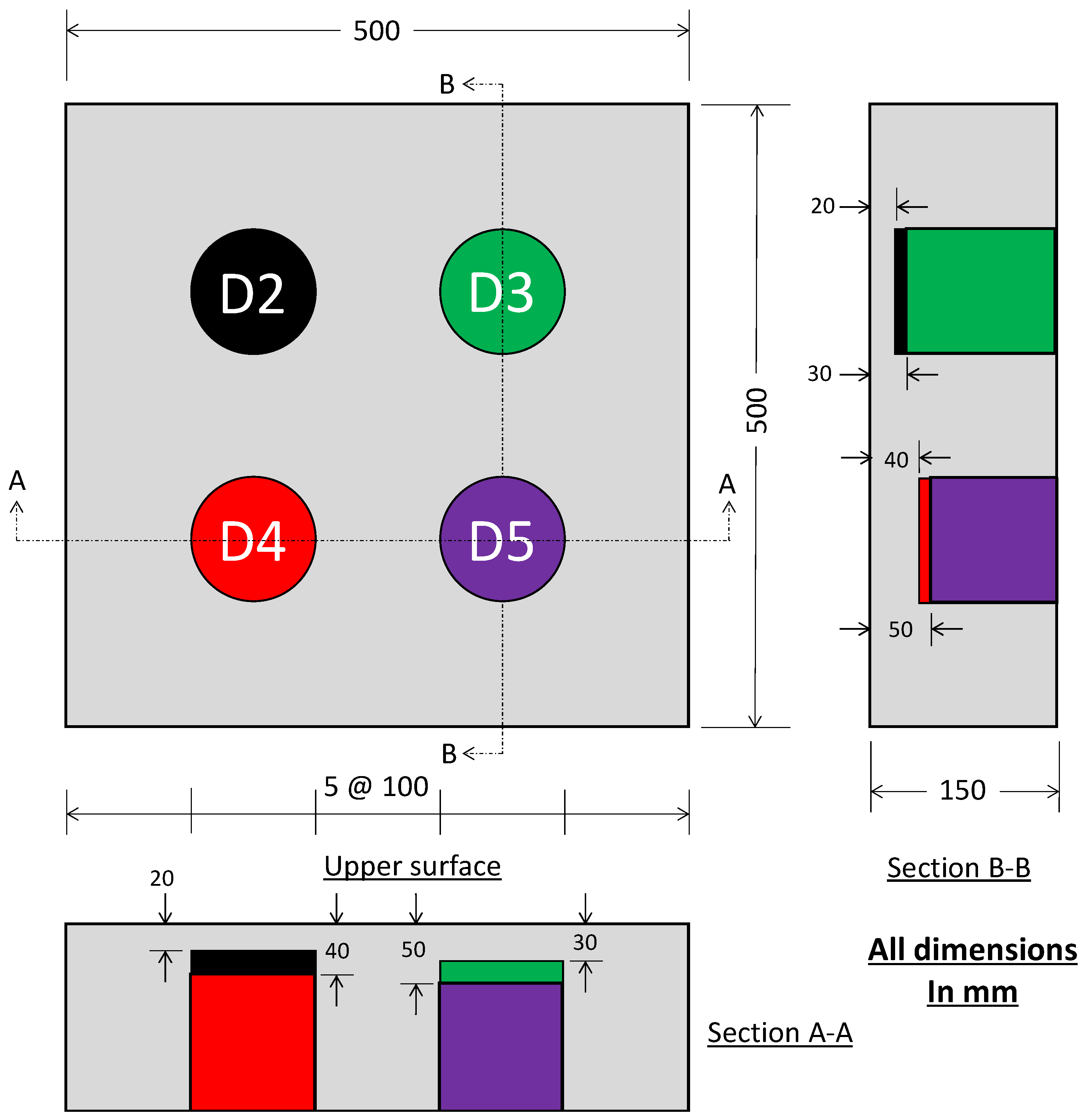

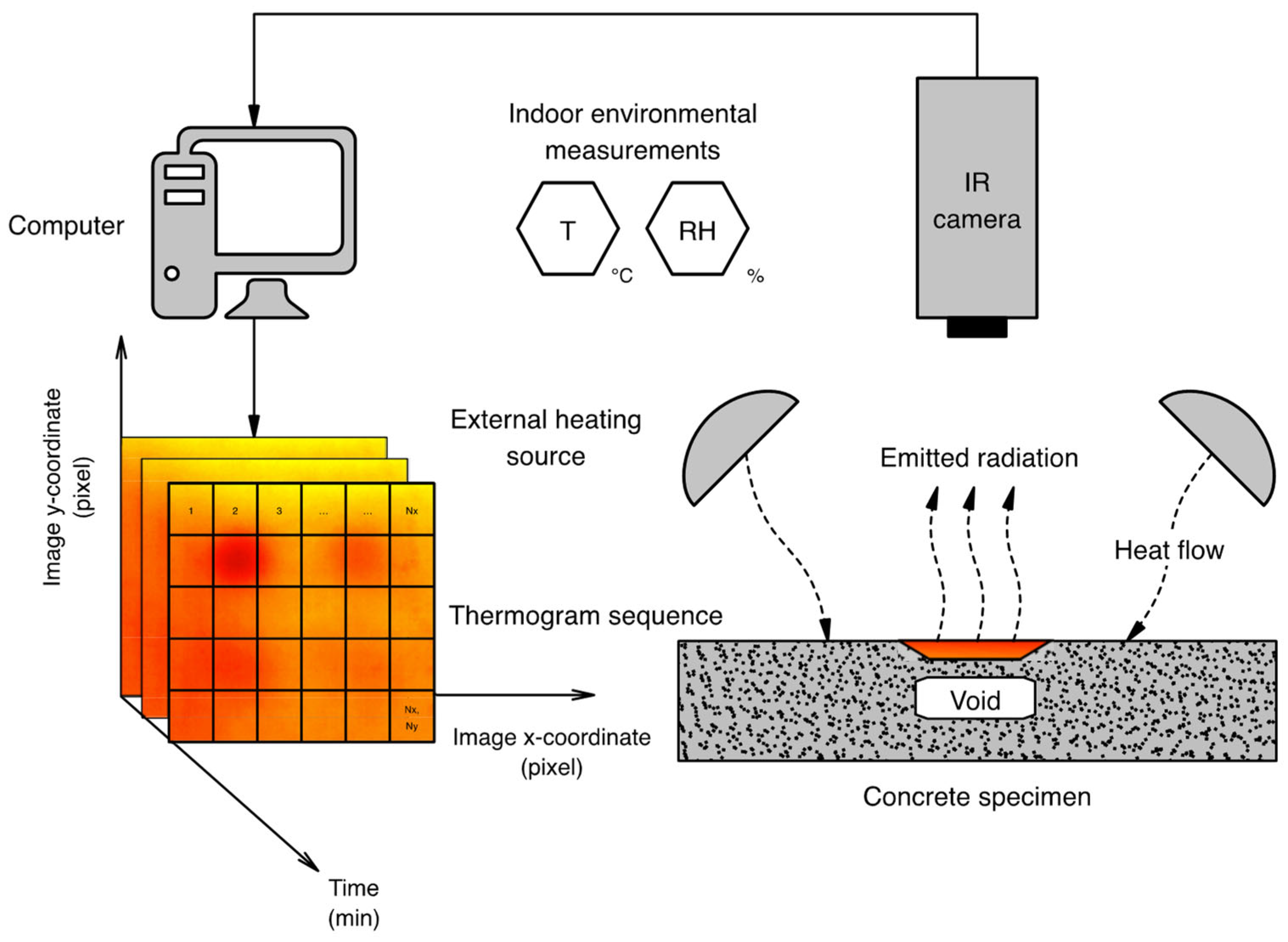

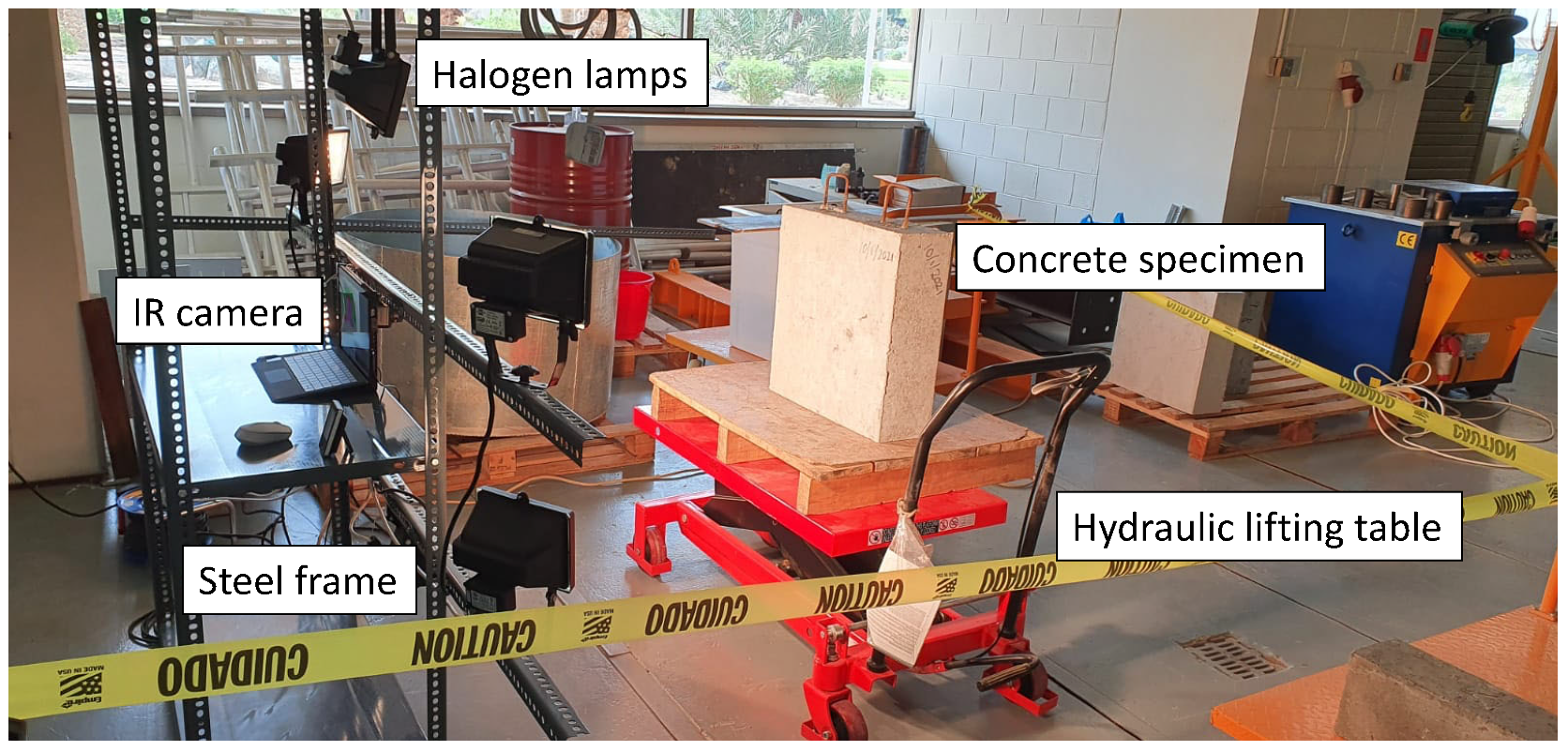
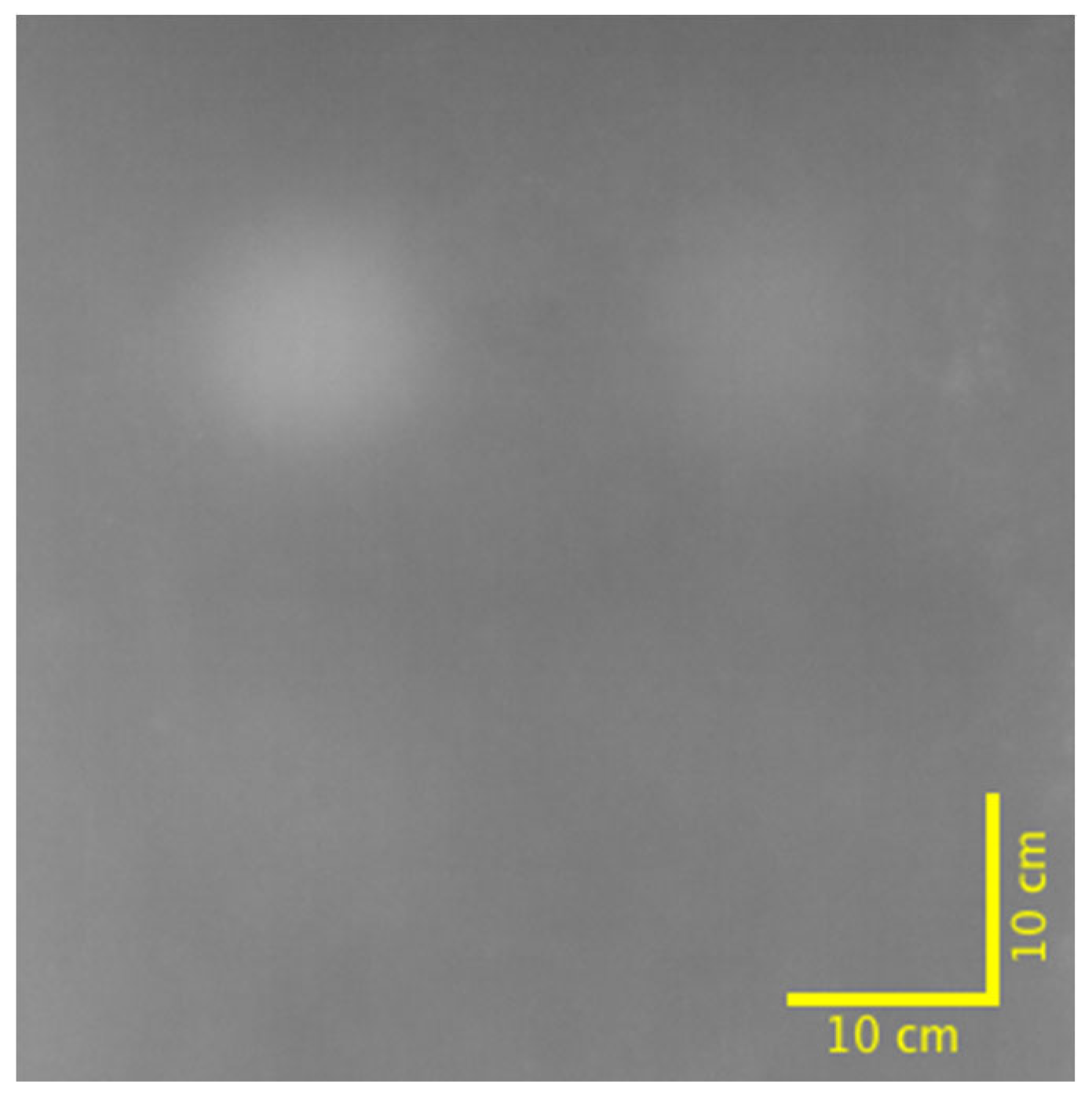
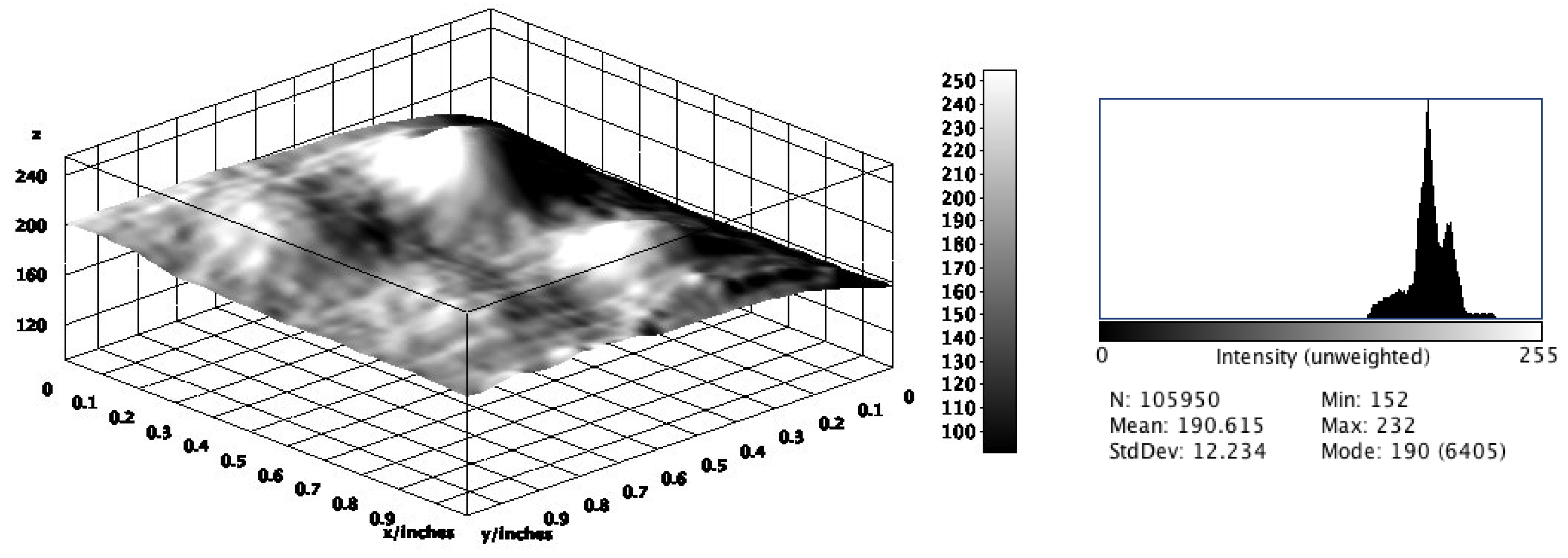

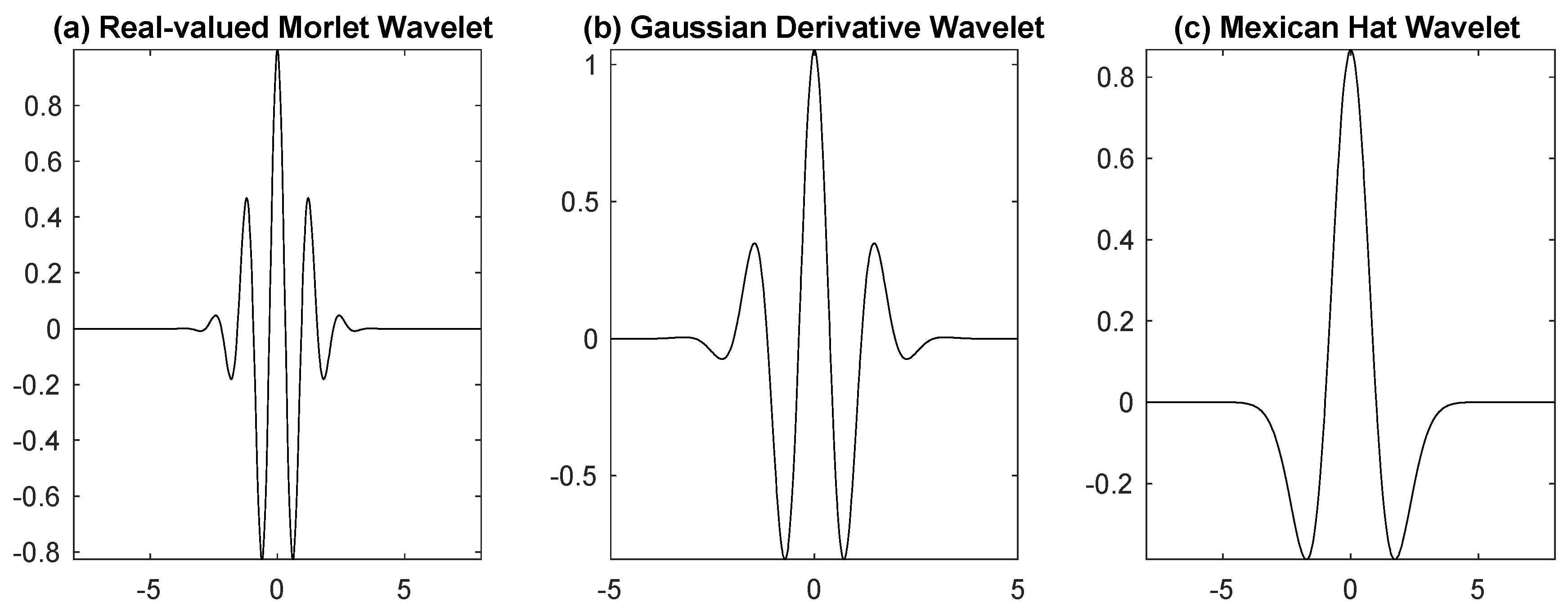
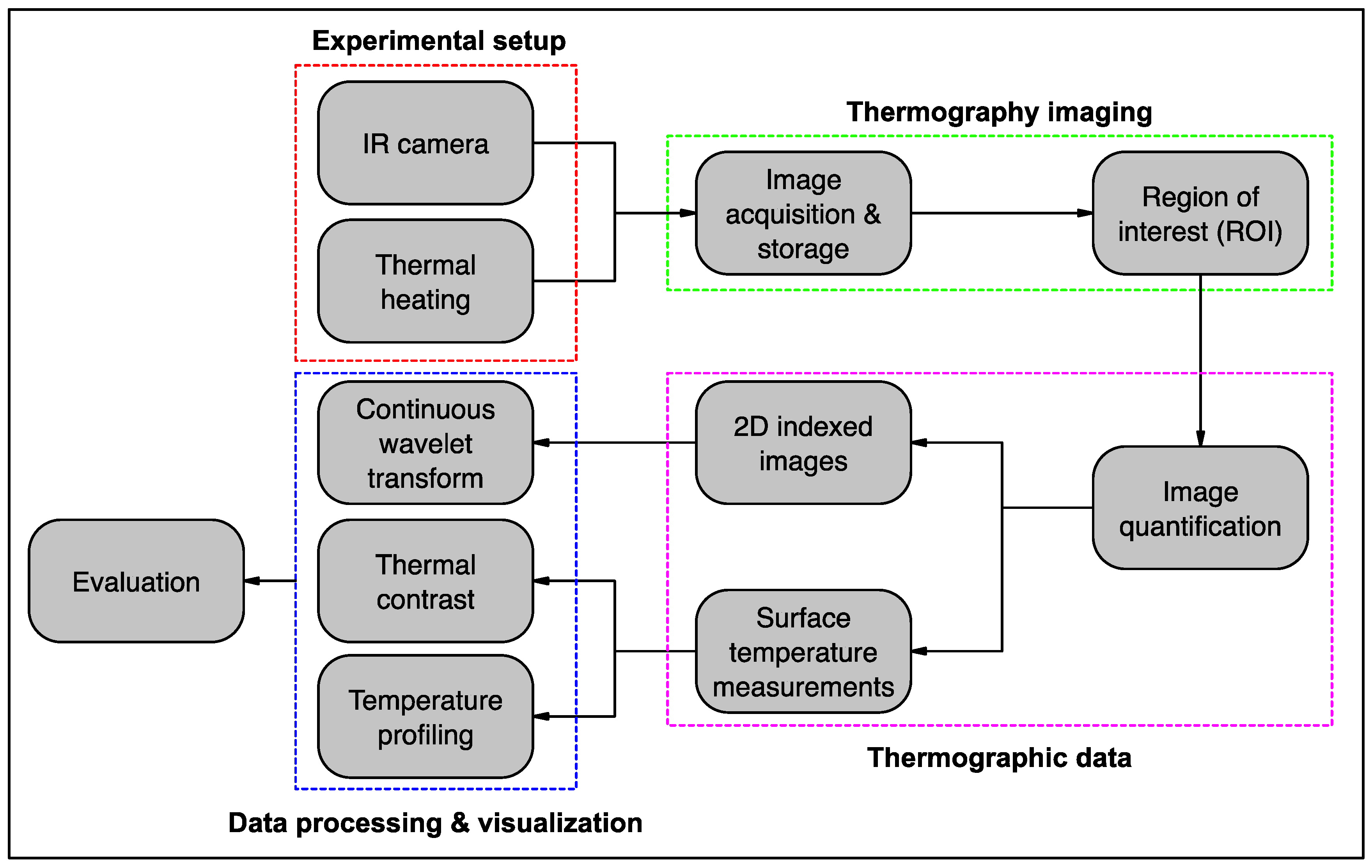
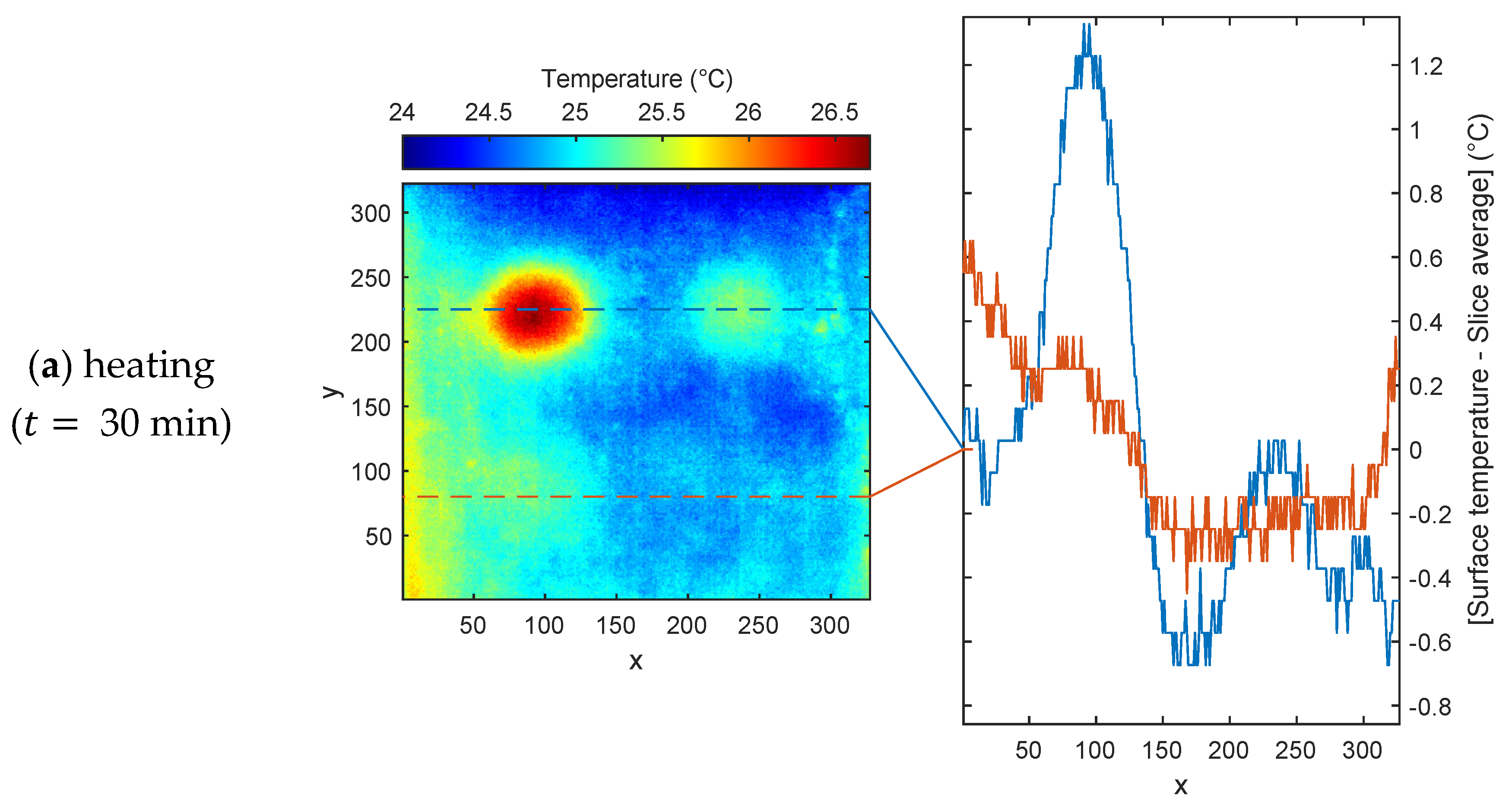

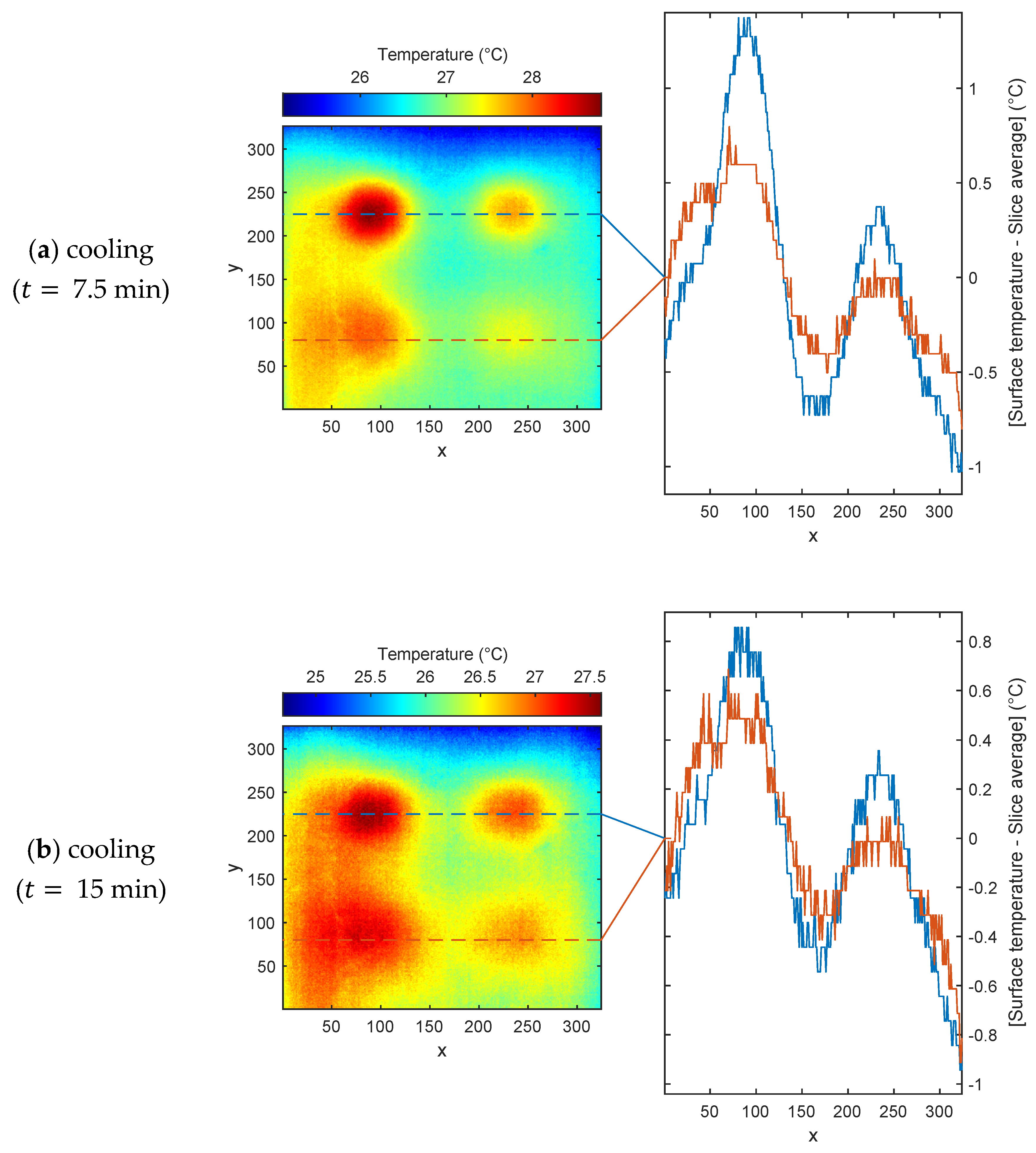
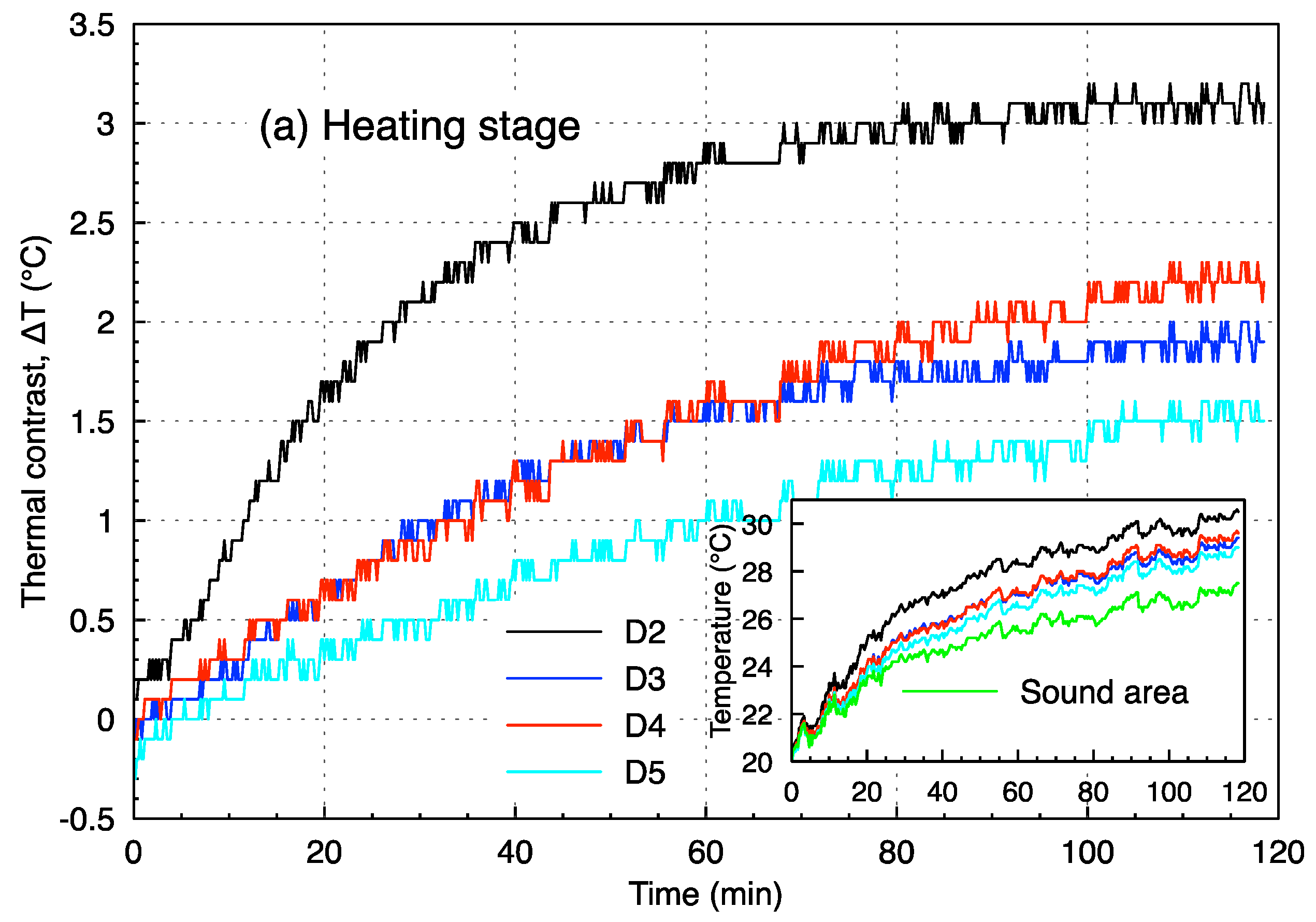
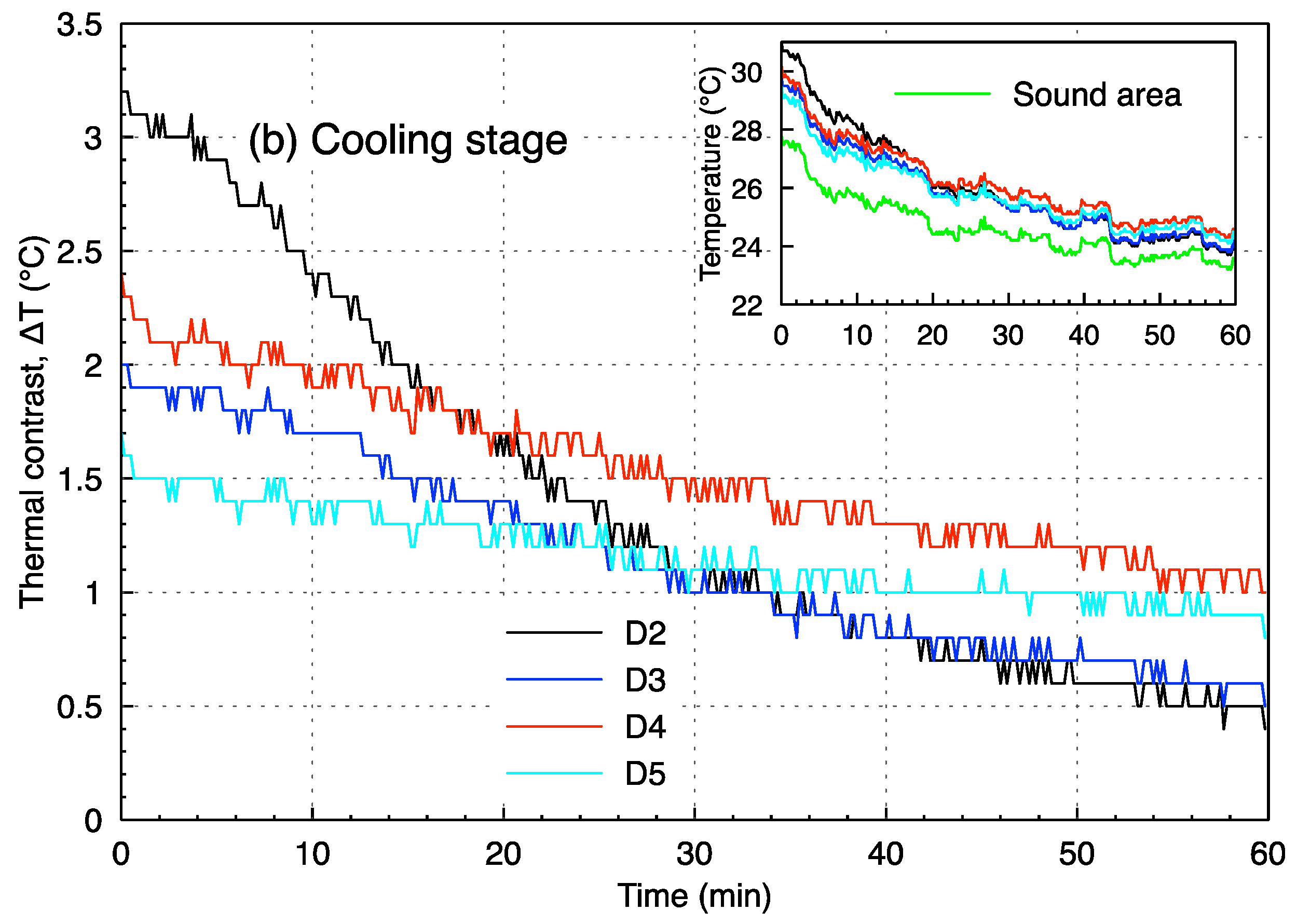

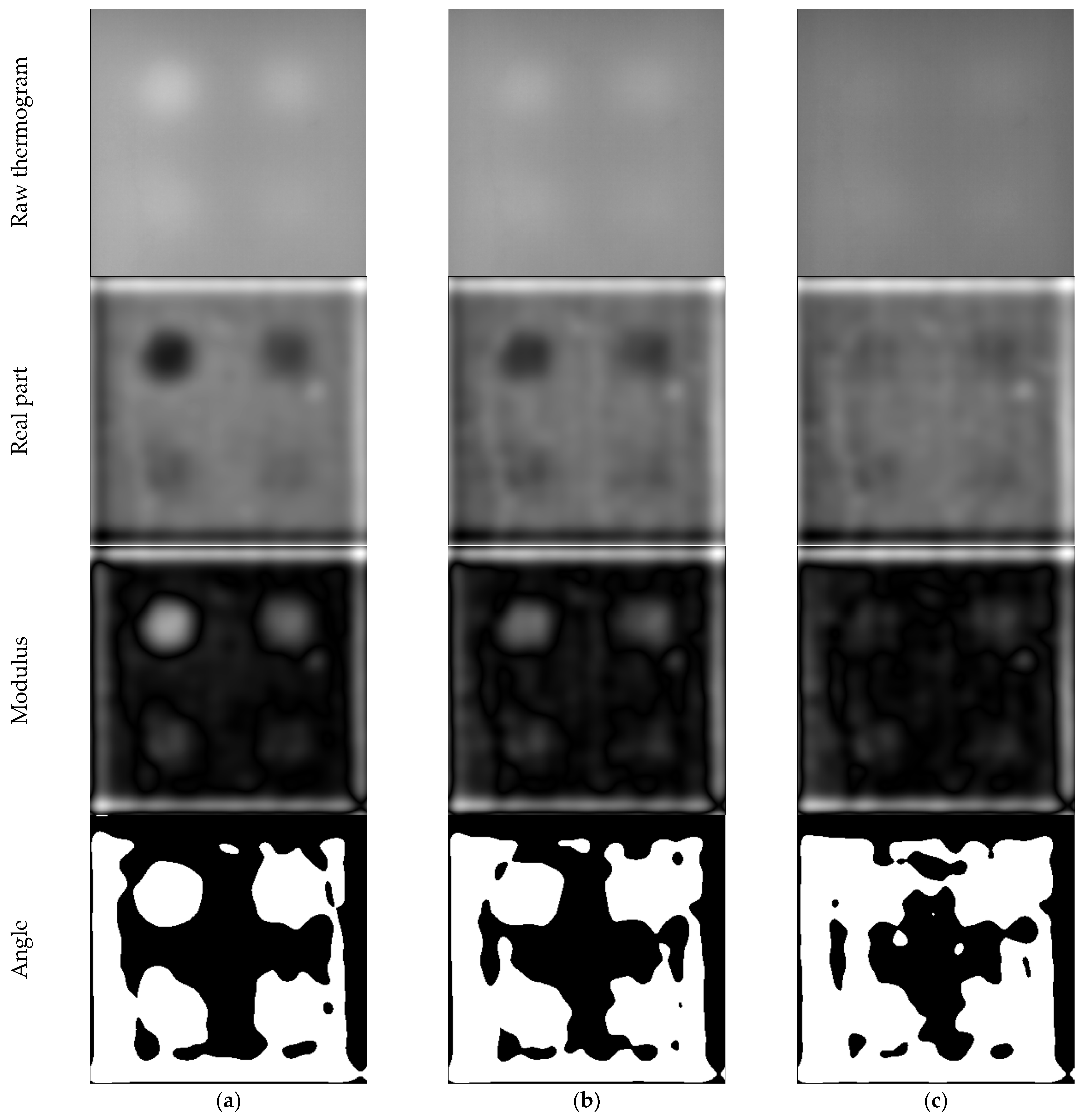
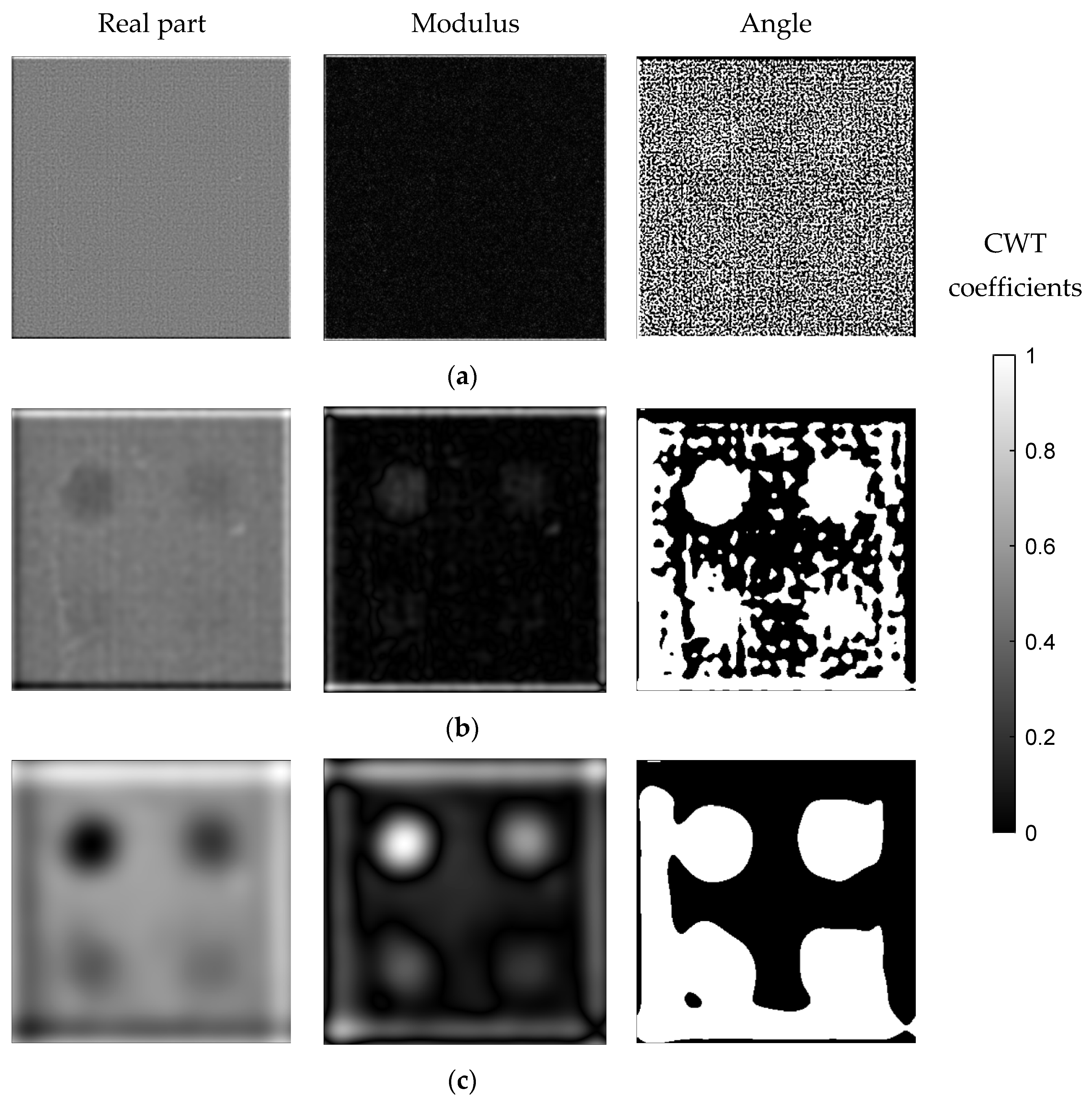
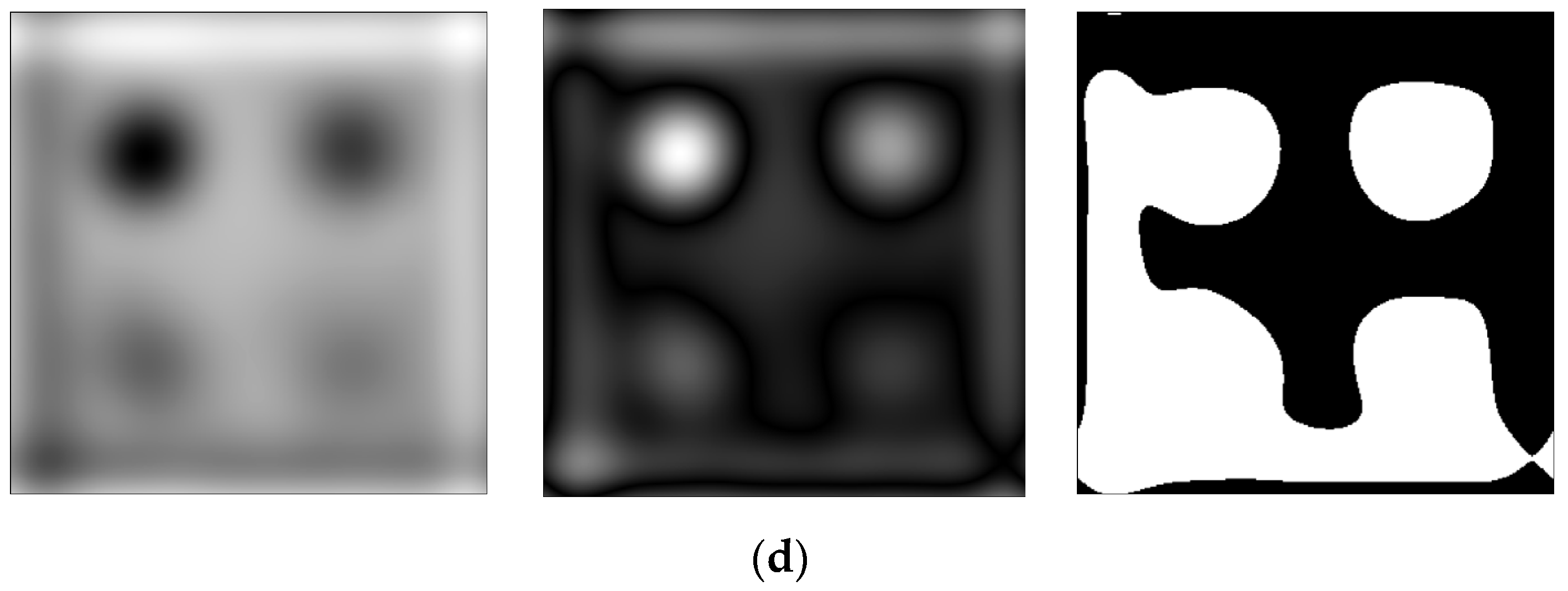
| Material | Amount in 0.05 m3 |
|---|---|
| Water | 8.84 L |
| Ordinary Portland cement | 18 kg |
| Coarse aggregate (max. 9.5 mm) (dry) | 38.4 kg |
| Fine aggregate (dry) | 60 kg |
| Superplasticizer (MasterGlenium SKY 504E) a | 350 mL |
| Cube No. | L (mm) | W (mm) | H (mm) | Maximum Load (kN) | Compressive Strength (MPa) | Compressive Strength (kg/cm2) | Weight (g) | Density (kg/m3) |
|---|---|---|---|---|---|---|---|---|
| 1 | 100.3 | 99.7 | 102.4 | 444.7 | 44.5 | 453.6 | 2355.7 | 2300.5 |
| 2 | 100.1 | 99.9 | 101.9 | 432.6 | 43.3 | 441.3 | 2355.7 | 2311.8 |
| 3 | 99.9 | 101.7 | 101.9 | 429.0 | 42.2 | 430.7 | 2327.5 | 2248.2 |
| Average | 43.3 | 441.9 | 2346.3 | 2286.8 |
Publisher’s Note: MDPI stays neutral with regard to jurisdictional claims in published maps and institutional affiliations. |
© 2022 by the authors. Licensee MDPI, Basel, Switzerland. This article is an open access article distributed under the terms and conditions of the Creative Commons Attribution (CC BY) license (https://creativecommons.org/licenses/by/4.0/).
Share and Cite
Saleh, A.K.; Sakka, Z.; Almuhanna, H. The Application of Two-Dimensional Continuous Wavelet Transform Based on Active Infrared Thermography for Subsurface Defect Detection in Concrete Structures. Buildings 2022, 12, 1967. https://doi.org/10.3390/buildings12111967
Saleh AK, Sakka Z, Almuhanna H. The Application of Two-Dimensional Continuous Wavelet Transform Based on Active Infrared Thermography for Subsurface Defect Detection in Concrete Structures. Buildings. 2022; 12(11):1967. https://doi.org/10.3390/buildings12111967
Chicago/Turabian StyleSaleh, Ali K., Zafer Sakka, and Hasan Almuhanna. 2022. "The Application of Two-Dimensional Continuous Wavelet Transform Based on Active Infrared Thermography for Subsurface Defect Detection in Concrete Structures" Buildings 12, no. 11: 1967. https://doi.org/10.3390/buildings12111967
APA StyleSaleh, A. K., Sakka, Z., & Almuhanna, H. (2022). The Application of Two-Dimensional Continuous Wavelet Transform Based on Active Infrared Thermography for Subsurface Defect Detection in Concrete Structures. Buildings, 12(11), 1967. https://doi.org/10.3390/buildings12111967







